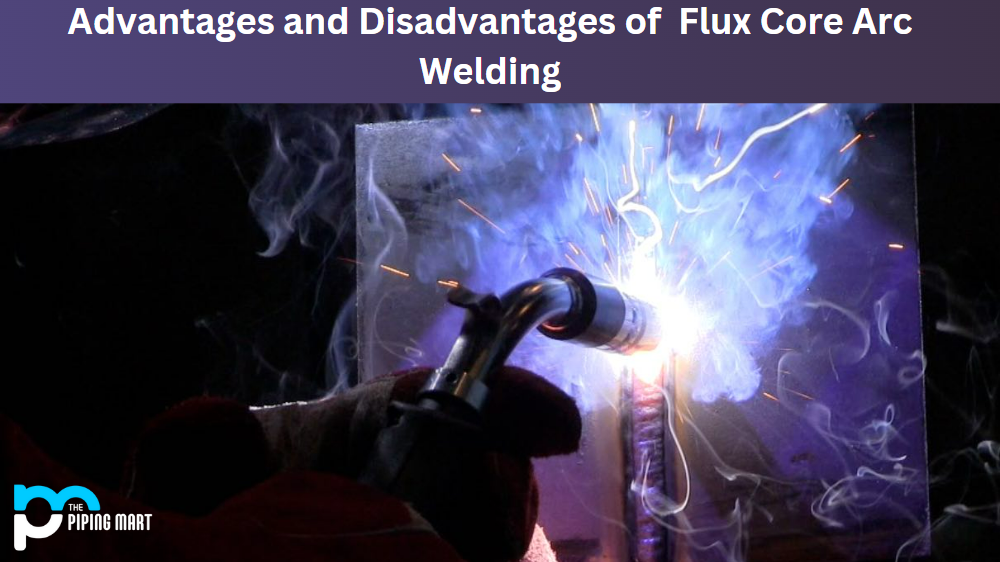Flux core arc welding (FCAW) is a popular form of welding that uses a consumable wire electrode and an externally-supplied gas shield, which produces an electric arc between the wire and the workpiece. FCAW is often used in welding projects that involve thick materials, as it can penetrate deeper than other types of welding. It’s also relatively quick and easy to master compared to different welding processes. But, like all forms of welding, there are advantages and disadvantages associated with FCAW. Let’s take a closer look at what those are.
Advantages of Flux Core Arc Welding (FCAW)
The biggest advantage of flux-cored arc welding is its speed; it’s generally much faster than other forms of welding, such as stick or MIG. This is because it doesn’t require additional rods or wires to be added during the process, as the flux-core wire acts as a filler material for the weld joint. The wire also has a higher deposition rate, meaning more material can be deposited in less time than other methods. Additionally, FCAW produces very little spatter, so clean-up time is significantly reduced compared to different welding processes. It’s also much easier to learn than other methods since fewer variables are involved in setting up the equipment.
Faster Welding Speeds
One of the primary advantages of flux core arc welding is that it can be performed at much faster welding speeds than other types of welding. A shielding gas shroud protects the molten weld pool from atmospheric contamination.
Increased Deposition Rates
Another advantage of flux core arc welding is that it has higher deposition rates than other types of welding. This means more weld material can be deposited quickly, increasing productivity.
Reduced Welding Costs
Flux core arc welding also has lower costs than other types of welding. This is because fewer consumables are required, and less waste is generated. Additionally, the increased deposition rates can lead to reduced labour costs.
Greater Flexibility
Flux core arc welding is also more flexible than other types of welding, as it can be performed in a wide range of positions. This includes vertical, horizontal, and overhead positions. Additionally, flux core arc welding can be completed in confined spaces where other types of welding would not be possible.
Increased Safety
Another advantage of flux core arc welding is that it is generally safer than other types of welding. This is because there is no need to use highly combustible gases, and the shielding gas protects the weld pool from atmospheric contamination.
Disadvantages of Flux Core Arc Welding (FCAW)
On the downside, FCAW requires special shielding gas cylinders and protective gear, which can add significantly to the cost of performing this type of weld job. In addition, it may not produce as strong a bond as other forms of welding, such as TIG or stick, due to its limited metallurgical properties, which can lead to porosity or cracking if not done correctly. Lastly, FCAW requires frequent changing out of consumable wires, which creates an increased amount of waste from discarded electrodes which must be disposed of safely according to local regulations.
Limited to Thin Materials
One of the primary disadvantages of FCAW is that it is limited to thin materials. This welding process is not well suited for thicker materials, as the arc can be challenging to maintain, and the weld bead can be uneven.
Requires More Skill
FCAW also requires more skill than other welding processes, such as shielded metal arc welding (SMAW). To create a successful weld, the welder must maintain a consistent distance between the electrode and the workpiece.
Can Be Messy
Another disadvantage of FCAW is that it can be messy. This welding process produces a great deal of smoke and fumes, which can harm the welder and those nearby. Additionally, the weld bead can be uneven and contain voids, weakening the weld’s overall strength.
More Expensive
FCAW is also more expensive than other welding processes, such as SMAW. This is because the equipment required for FCAW is more expensive, and the consumables (electrodes, etc.) are also more costly.
Health Risks
Finally, FCAW poses some health risks that other welding processes do not. This is because FCAW produces a great deal of smoke and fumes, which can contain harmful chemicals. Additionally, the arc produced by this welding process is very bright and can cause eye damage if proper safety precautions are not taken.
Conclusion:
Overall, flux core arc welding is an excellent choice for most metal fabrication projects when speed and convenience are important factors. It has many advantages over traditional stick or MIG welding, such as faster production times, reduced spatter levels and less clean-up afterwards. However, there are some drawbacks, such as higher costs due to extra equipment needed for shielding gas cylinders and protective clothing, plus more frequent wire changes resulting in increased waste disposal costs that must be taken into account before committing to this type of weld job on any project large or small. With proper training and attention paid towards safety protocols, however, FCAW can prove invaluable when tackling tough metal fabrication jobs quickly and efficiently with minimal risk.

A passionate metal industry expert and blogger. With over 5 years of experience in the field, Palak brings a wealth of knowledge and insight to her writing. Whether discussing the latest trends in the metal industry or sharing tips, she is dedicated to helping others succeed in the metal industry.




